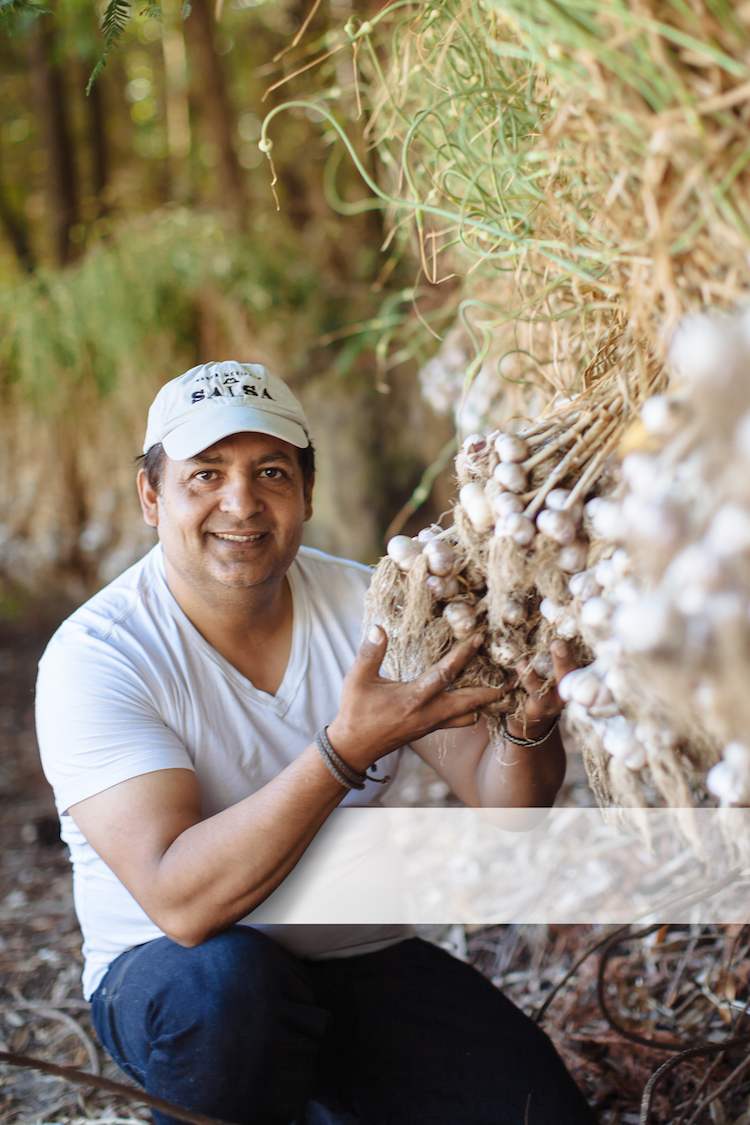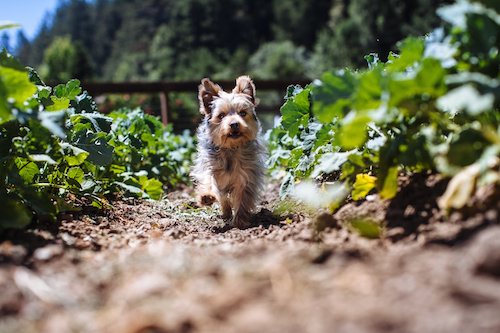Jorge Saldana farms to make better food for his tables.
There is a right way to cook beans and it’s probably not the way that you do it. “This philosophy of beans is very important,” says restaurateur Jorge Saldana, settling into a chair on the wide veranda of a house on his Guerneville property. Dried beans, for example, must be fresh—and seasonal.
“My mom would not use beans that were more than two or three months old. For her, it was brand-new, seasonal beans only,” Saldana stresses. “What most people don’t know is that old grains lose their nutrients, and I can assure that you that most of us probably get beans that are four or five years old.”
Once fresh beans are procured, they must be treated with lavish amounts of water and even more amounts of patience. Add six times the water as beans, Saldana says, and “cook them very, very slowly. That’s the trick. It takes about two to three hours, and you’ll get lovely beans.”
Saldana knows the farmer who grows his lovely beans so he doesn’t worry about getting musty seeds older than a kindergartner to slow-cook just right for his Cancún restaurant in San Francisco or his Tlaloc restaurant in Berkeley. Cinco, his 100-seat restaurant set to open at the end of August in Sebastopol’s Barlow marketplace, will receive these beans as well. He doesn’t use Rancho Gordo’s popular products because, he says simply, “I use this farmer. I know his practice. He’s just a local, very small farmer. He sells all his beans to us.”
The corn for Saldana’s tortillas and chips is processed into tortillas for his restaurants by another family whose practice is known to him. His late mother’s wisdom informs all the cooking. His father was a farmer. It’s all coming full-circle for Saldana as he prepares to open a guest house on his Guerneville land and Cinco, a new farm-to-table restaurant not too far down the road.
Saldana immigrated to the Bay Area from his family’s farm in the southern part of Jalisco in the 1980s in order to enroll in high school. Upon graduation, he enrolled in community college and majored in business. He started “a little tiny restaurant,” he says, in order to pay for school. Instead, he laughs, “I kept at the school of cooking, and that’s what I’ve been practicing for 24 years already.”
He pets the dog sleeping by his feet. “My dad was a farmer, so I learned how to hire people, and quality control,” he says. “I basically grew up as a farmer; I know how to farm. I didn’t know how to run restaurants. But I knew how to grow food, and my mom was an excellent chef—and that’s why I’m here cooking.”
Saldana settled in San Mateo and his little tiny restaurant became two well-known and bustling Mexican food spots amid an increasingly complex gastronomic map. Canún and Tlaloc feed hundreds of people from 50-item menus each day, and are known for their vast salsa offerings. A full salsa bar accompanies each restaurant, offering some 30 different variations on this classic Mexican accompaniment, from traditional tomato-based salsas to those made from strawberries, avocadoes, and mangos.
Saldana says that a mere 30 varieties of salsa is child’s work. His mother would create a different salsa for each dish she served. “Five different tacos,” Saldana pronounces with satisfaction, “five different salsas. She could make over 100 different salsas. It was very unusual, even for Mexico.”
Cinco, the new restaurant planned for the Barlow, will have a more curated menu than its sister restaurants, with just a few enduring dishes like tacos bolstered by a rotating roster of four to five seasonal dishes, and a massive outdoor patio with a robust bar.
Saldana credits his parents for a background that allowed him to become successful in California. He says that he has a “flavor memory” that allows him to recall dishes his mother cooked when he was a small child and recreate them. “I’m an interpreter,” he says of his culinary recollection, “and I’m lucky to be able to. Sometimes, I’ll just think of a flavor and just do the process on my own.”
Saldana bought the Guerneville property, a 130-acre parcel near Armstrong Redwoods with 10 arable acres for farming, in 2005. It had been the original home of Traditional Medicinals, the herb company. He had a friend in Cazadero and was accustomed to visiting Sonoma County regularly when the land bug bit.
“The idea of getting the farm was to make better food,” he says. “When I had the feeling about wanting to be in contact with the earth and to start farming, I spoke to this man who I know in the real estate business and asked him to find me an acre or two acres, that would be great.”
The agent instead found a lush riparian valley surrounded by redwood trees with hiking trails and natural springs that had enough land, sun, and water to farm and a historic house perfect for transforming into a small resort for wedding parties and other guests. Saldana fell in love. He and his family moved to Guerneville full time three years ago so that he could be on the land more often.
“Farming is something that you have within you. It’s nice to understand that you have it and you can do it,” he says. “And, I was missing the fresh heirloom tomatoes, cilantro, the onions. Just getting cilantro from the fields out here is intense. That’s the beauty of cooking Mexican food.” Saldana has two assistants who come most days to help maintain the fields but otherwise likes to oversee and work the land himself. He eschews GMO corn for any of his products and grows the large-seeded heirloom Hickory King corn. “I actually like to grow corn that hasn’t been modified or at all hybridized,” he says. “I like to use the old, old corn, and it’s just beautiful.”
But his farming craft best expresses itself in the peppers that are being cultivated onsite. Open-pollinating and saving seeds from Jalisco and elsewhere, Saldana hopes that he’ll one day be able to grow a full slate of different types in his fields, which receive far more rain and fog than do the plants’ native climates.
Farming is something that you have within you. It's nice to understand that you have it and you can do it. Jorge Saldana
“I grow at least 30 varieties of pepper right now,” he says. “At one point, I was trying to grow 100 varieties and that’s still my goal, but it’s very hard to grow all of the peppers here. All of the varieties have had to adjust to the climate over four or five years, so it takes a long time. A lot of them die and, of the ones that survive and produce peppers, I take seeds and replant, and that’s the way I get them used to this climate. It’s going to take about 10 years, but then I’ll have close to 50 to 60 varieties of hot peppers, very unusual hot peppers from all over the world.”
Saldana’s fields currently provide some of the produce for his Bay Area restaurants. The intent with the new Cinco restaurant is that the farm will provide all of the produce. Saldana already freezes thousands of pounds of tomatoes each year to overwinter the salsas he is known for. With Cinco’s reduced slate of fare, he thinks that he’ll be able to produce what he needs right from his own property.
The dog is restless and shadows cover the veranda, but the visitor hesitates, unwilling to leave. Saldana is used to this.
“People ask me, ‘Can I come to your farm? We’d just like to walk around.’ I say, ‘Welcome. Everyone is welcome to come and look around.'”
He looks down at the fields greening in the last of the afternoon sun.
“If I see people being happy because they’re here, it’s a joy to me.”
Article Resources:
Jorge’s farm welcome visitors. To learn more, go to:
To keep up with news of Cinco’s forthcoming opening, go to:



